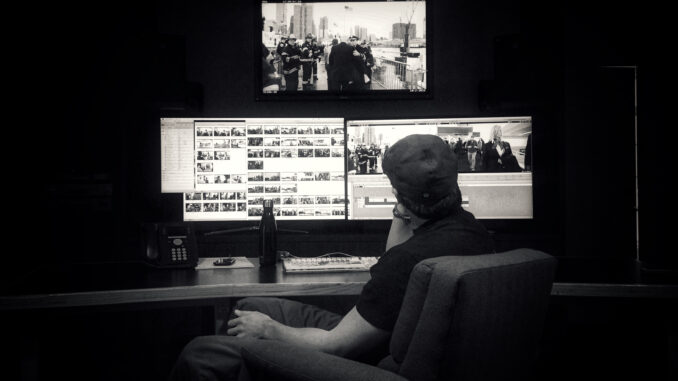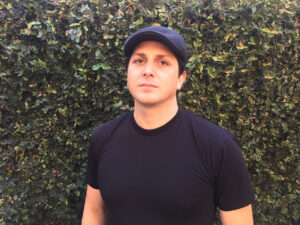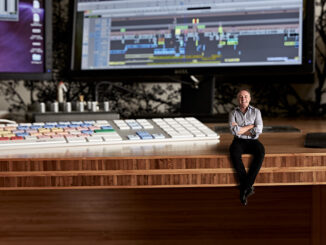
By Rob Feld
Blu Murray put in his time and was rewarded. After 10 years working for Clint Eastwood at the director’s company, Malpaso, Eastwood’s editors were tied up on another project, but it was time to cut “Sully.” Murray had never cut a feature film on his own before, but Eastwood, known for giving loyal collaborators their chance, did just that. When asked about the decision for this article, Eastwood said plainly, “Blu had worked for me for a long time and I was happy to give him the chance to cut ‘Sully.’ It was the first movie he cut on his own and he did a great job.”
Murray had paid dues before making it to Malpaso, as well. When he was first starting out and unable to find work in a cutting room, he worked in sound at Sound Storm. “The people there were my first mentors,” he recalled. “They quite literally taught me how to work, and I saw firsthand how much it meant to get into the union from the other drivers who were starting out there. The hours digitizing SFX from DAT, copying lined scripts for dialogue editors, making sure cue sheets were taped perfectly and ready to go for the mixers taught me to take pride in every little thing, no matter how insignificant it may seem at the time. It all adds up.” Murray is the son of Eastwood’s longtime sound editor, Alan Murray, who died earlier this year.
After “Sully,” Murray cut “The 15:17 to Paris” for Eastwood, “Glass” for M. Night Shyamalan, and recently finished “The Water Man” for actor-cum-director David Oyelowo. The fantasy-adventure story — which lands in theaters this Friday — follows Gunner (Lonnie Chavis), a young boy on a quest to find the secret of immortality, to save his sick mother. Gunner runs away from home to find a mythic figure in the forest, the Water Man, who he thinks can give him the secret. Gunner’s father, Amos (Oyelowo), who had grown distant from Gunner, goes in search of his son and, in so doing, learns everything about him that he had missed.
The forest is a scary place, and Murray must balance performance and the world of kids’ fantasy with the drama transpiring back home with Gunner’s family. The attention to detail he learned back at Sound Storm is evident in his work, as is the methodical patience one can imagine was imbued in him working for Eastwood all those years. As Murray invested in his mentors, they clearly invested in him, and he has seen returns in spades.
CineMontage: You clearly found a good thing at Malpaso, but did you have an apprenticeship experience? What was the most useful thing you learned from a mentor?
Blu Murray: I consider working on “Catwoman” my apprenticeship. I started the film as a PA and finished as an assistant editor, although that credit was just a kindness on their part. I was their apprentice. Sean Wimmer, the post-production supervisor, was kind enough to promote me to apprentice editor as long as I continued doing all the PA work as well. The editor, Sylvie Landra, who cut “Lèon: The Professional,” and who I consider one of the most talented editors in existence, would come into the assistant’s room after she locked reels and show me how to export cut lists, and help with turnovers. I learned everything I could from assistant editors, Kate Baird (who got me the job), Soline Guyonneau, and Gary Roach. I can’t possibly thank them enough for the time they spent with me and knowledge they shared. I’d have to say, the most useful thing I learned on that film was that you can’t fall asleep when you’re checking reels, no matter how late it is.

You were in Clint Eastwood’s world for so much of your formative life. How did the transition happen from assistant editor on “American Sniper” to editor on “Sully?” Does it say anything about the environment Eastwood creates?
Murray: I had been an assistant editor at Malpaso for about 10 years when “Sully” started pre-production. Clint’s editors were away cutting another film, and the transition happened just like that. It speaks volumes about Clint and the environment he created with his company, Malpaso. When you tell people how Clint works, the typical response is something like, “Well, of course he can do it that way, he’s Clint Eastwood.” But what I think they fail to realize is that he’s always done things his way, and that’s what made him the legend, icon, filmmaker he is today. He’s earned every single freedom he enjoys as a director by forging his own path. Who else in the world would put a 34-year-old assistant editor—who had never cut a film on his own—in the editor’s chair for the first time on a $60 million studio film starring Tom Hanks and Aaron Eckhart?
What is your process? What does your collaboration look like with Eastwood?
Murray: During dailies, I like to cut from instinct, putting the scenes together in a way that feels natural to the story being told. If you sit back and watch dailies, the images will speak for themselves. The performances, the angles, the takes that belong in the movie will become obvious. Then, I just construct each scene around the moments of magic the director has captured on film. Clint always steps away from the project for a couple of weeks after filming, giving himself a beat and his editor time to put the first cut of the film together. Then, one day, usually without any warning at all, he walks into the cutting room, ready to get back at it with a fresh set of eyes. In my experience, Clint enjoys watching the cut in its entirety. He does this throughout the process, each time focusing on different sections of the film to work on. I’ve never actually asked him about it, but it feels like, each time he watches the film, he allows it to speak to him, instinctually knowing what sections he wants to focus on for each pass of the editing process. It continues like this until one day you hear the words “Alright, that’s enough of that.”
Eastwood speaks a good deal about being intuitive and not over-intellectualizing while shooting. Do you see this mentality carrying over to the post process? Or would you frame it differently?
Murray: No. I’d frame it exactly like that. He lets his intuition guide him, he doesn’t second guess, and when it feels right to him, he locks the cut.
What sort of preproduction discussions do you like to have with a director?
Murray: I want to hear first-hand how they envision the film. The tone they’re after. Any specific things they might want to do in the cutting room. Then, I like to go through the script again and freely offer any thoughts I have. It’s always completely up to the director, whether they address them or not, but I feel like I have a good sense of moments they might want to capture on film, and have handy as options later on down the line in post.
David Oyelowo was a first-time director. Did that change how you approached your work?
Murray: No. Not at all. I never once thought of David as a “first-time director.” He surrounded himself with great people, he was masterful on set, and he knew what he wanted in the cutting room. David is one of those people who is just kind of brilliant at everything he does. When we would have our discussions after running dailies, I always spoke to him as the director, sometimes forgetting that he was also the lead in the movie. Then, when I got back to cutting, I’d realize that I forgot to tell him what a great performance he had given. I don’t think the man ever had a bad take.
What does music add to your work process? When do you like to bring it in?
Murray: I don’t cut with music at first. I want to know that the scenes are able to convey emotion and tell the story on their own. Music is only going to enhance the experience. I like to give composer (and all departments) as much time as they need to do their job. As soon as the director is happy with the shape of the film, it’s nice to bring the music team in and begin working together on the project.
What do you need from a director and what are ways you have worked with one in particular that you have appreciated?
Murray: I don’t need much from a director. I’m there to bring their vision to life. I guess, just the freedom to speak plainly. Sometimes, in the process, there’s pressure to make compromises and changes to fit an agenda. I’ll always be the counterpoint to that, saying whatever I need to say in service of the story, the characters, and the cinematography. I appreciated how passionate M. Night Shyamalan was during the editing process. He was energetic, inspired, and always on a quest to unearth the best version of his film. When we would play back scenes or have screenings, I noticed that he would have this way of moving around in his seat with the action of his movie, almost as if he was seeing it for the first time and couldn’t contain his excitement. That’s just how invested he is, how consumed he is by the art, and it was an absolute honor to be a part of [it].






